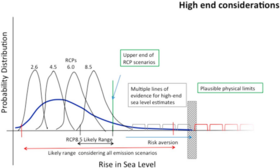A conceptual framework for high-end sea-level rise estimates for stakeholder applications
A new conceptual framework to help users to apply sea-level rise information and better inform the science community about these needs. How can sea level rise information be best derived and applied to guide and support coastal decision makers and stakeholders for planning long-term coastal adaptation responses and mitigation targets?

Information on high-end sea level rise projections has been usually derived either from a likely range of future sea-level rise under the various simulated climate change scenarios and anthropogenic CO2 emissions (i.e. the so-called RCP8.5 scenario) in the IPCC Assessment Report (AR5) or from independent ad-hoc studies and expert solicitations. The interpretation of this information is left to experts’ judgement.
Ideally, users require high-end sea level rise information that has to account for all plausible yet unknown future emission scenarios, in addition to all involved natural variability and physical mechanisms of sea level (i.e. the upper tail of a joint sea level frequency distribution), which is not possible. As concluded at the last IPCC AR5, there was insufficient evidence in published literature to describe the shape of the tail of the probability distribution or any asymmetry of it, both essential information to risk adverse stakeholders. Estimates of high-end sea-level rise become increasingly uncertain further into the future. Our limited understanding of physical processes driving Antarctic ice sheet dynamics and the lack of detailed knowledge of future emissions represent the largest uncertainties, particularly as regards long-term sea-level rise projections.
The new paper Stammer et al., 2019 contributes towards linking robust sea- level science and IPCC-information with coastal climate services, stakeholder needs and local user requirements in a more practical way, by providing a generic conceptual framework to help users to apply sea-level rise information as a function of time scale and better inform the science community about these needs.
In the absence of high-end sea level information representing the upper tail of a single joint sea level frequency distribution, the newly proposed framework enables to infer the required information from explicit conditional statements (lines of evidence) in combination with upper (plausible) physical bounds, while acknowledging the growing uncertainty as we look further into the future. In addition to scientific accuracy, it also considers the wide range of risk aversion levels and the various types of stakeholder decisions and applications on coastal policy and adaptation.
Very importantly, by linking sea-level science and stakeholder needs, the proposed conceptual framework contributes towards a more transparent of high-end sea level rise estimates to a wider audience and to a more constructive guidance for stakeholders which is often absent.
This work is a collaboration of an international team of sea level experts from Germany, the Netherlands, UK, Australia, France, Singapore and United States. The content of this publication initially emerged during the "High-end sea level scenarios" Workshop which was held in Hamburg in September 2017, partially supported by the SPP SeaLevel and the WCRP Grand Challenge on Regional Sea Level Change and Coastal Impacts.
This innovative work is published at Earth's Future:
